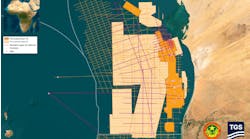Corrections critical for 3D and 4D surveys
As the industry moves toward exploring and producing in deeper water areas such as the Gulf of Mexico (up to 3,000 m water depth), velocity variations in the water column require a closer look. In the past, seawater velocity was treated as constant (with a value of 1,500 m/s) because its variations generally have little influence on structural imaging. Acquisitions crews observed some variations like the strong velocity contrast in the GoM’s Orca basin due to salt outcrop, which creates a reflection in the middle of the water column at 3 sec. These remain an interesting peculiarity.
Seismic reservoir characterization and seismic reservoir monitoring (4D) require a high degree of fidelity in seismic amplitudes and travel times. In the presence of seawater velocity variations, amplitude and travel time can be perturbed and can prevent a suitable quantitative analysis of 3D and 4D seismic data.
The subject of water velocity has been studied by acousticians, who measured the speed of sound in laboratories under various conditions of water temperature (T in °C), salinity (S in part per thousand or ppt), and pressure (or depth in m). Many equations predicting velocity from these parameters have been published. Medwin’s equation is the most manageable, yet it remains very accurate compared to more complicated relationships.
Medwin’s equation:
Velocity = 1449.2 + 4.6T-0.055T2 + 0.00029T3 + (1.34-0.010T)(S-35) + 0.016D
This equation shows that, under typical sea conditions (T = 15° C, S = 35 ppt), velocity increases by 3.2 m/s for a temperature increase of 1° C, by 1.2 m/s per 1 ppt of salinity increase, or by 1.6 m/s as one goes deeper by 100 m. In general, salinity usually varies very little (by 1 or 2 ppt over large areas) and the influence of depth is static. In other words, depth imposes a constant gradient to vertical velocity profiles that does not change in time or with location. Therefore, the main parameter creating dynamic water velocity variations is the temperature.
From a seismic point of view, temperature (and therefore velocity) varies both laterally and vertically (due to spatial distributions and vertical gradient), as well as with calendar time. Many external parameters affect temperature distribution over different time scales: sun heating and night cooling or sea conditions affect surface temperature daily and can produce intra-survey variations, whereas global currents or seasonal weather changes can affect time-lapse surveys or infill acquisition.
Typically temperature in the deep GoM can vary at the surface between 30° C in summer to 15° C in winter, and decrease down to 4° C below 1,000 m. It is the seasonal variations that have the most impact on seismic data as they can change velocity by up to 40 m/s at the surface and by up to 20 m/s anywhere between 100 m and 1,000 m, making seawater velocity variations a critical issue in 3D surveys with infill data and in 4D.
On pre-stack data, the changes of velocity in the water column increase or decrease travel time. This affects the common depth point (CDP) gathers and the velocity analysis by creating scatter along the normal move out (NMO) corrected and uncorrected gathers, preventing an optimum velocity analysis and reducing the coherency of the stack. Therefore, post-stack data suffer from both time mis-positioning and loss of amplitude. This is illustrated in the first figure on a seismic line from the GoM.
The top image shows the data processed through to stack without any specific concerns regarding the water velocity variations. The circles show a number of zones where the amplitudes are inconsistent, containing more noise and with less continuous horizons. A specific processing step removes the effects of seawater velocity variations on the pre-stack data.
The resulting stack (middle) shows significant improvements over the non-corrected stack: better signal-to-noise ratio, more consistent amplitudes, and more continuous horizons. The error caused by seawater velocity variations in post-stack travel times and amplitudes is calculated by comparing the uncorrected data with the data free of those artifacts (i.e., after the correction), along one horizon across the section. The bottom section shows that the travel time error is not too significant (generally between +/- 2 ms), but the impact on amplitude can be very important (up to 40% amplitude loss).
These errors can be very damaging on analyses that rely highly on preserved amplitudes, such as amplitude versus offset or inversions. In 4D, even travel time variations as small as 1 ms can create significant errors in time-lapse repeatability. The second figure illustrates this issue by modeling time-lapse data perturbed by time and amplitude errors in a similar way to the previous GoM example. The resulting time-lapse signature carries an error as large as 45%.
These two examples highlight the critical issue of seawater velocity variations in 3D and 4D seismic analyses. In the GoM case, the improved image has been processed through a specific dynamic water velocity correction. Several techniques exist. The most common, often called marine statics, consist in aligning a specific event for neighboring traces acquired at different times (e.g., sail-lines or infill), and applying a bulk shift to the whole trace.
- This wavelet example shows the perturbations introduced by seawater velocity variations in 4D surveys. The dark blue wavelet represents post-stack data from the baseline acquired with no particular seawater velocity variations (dominant frequency = 50 Hz). The blue wavelet represents post-stack data perturbed by seawater velocity variations in a similar way than from the previous case (time error = 1 ms, amplitude error = 25%). The resulting difference (red) shows an artifact of 45% of the original data exists even without genuine 4D effects.
Water velocity variations can be critical and ignoring them can damage 3D reservoir characterization analyses. In 4D even small variations can have a significant impact, masking the real signature or introducing artifacts. In deepwater areas, they should be analyzed. If significant water velocity variations are found, they should be removed using specific processes.





